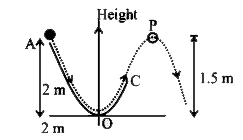pπ−pπ multiple bond is seen in
Mostly carbon
All carbon family member
Sn but not in carbon
Boron family and not in carbon family
The correct Answer is:A
To solve the question regarding the presence of p pi - p pi multiple bonds, we can follow these steps:
1. Understanding p pi - p pi Bonds:
- p pi - p pi bonds are formed when two p orbitals from different atoms overlap sideways. This type of bonding is typically seen in elements that can form multiple bonds, such as double or triple bonds.
2. Identifying Relevant Elements:
- The question provides four options, and we need to identify which of these elements can form p pi - p pi multiple bonds. The most common elements known for forming such bonds are from the carbon family (Group 14 of the periodic table).
3. Catenation Tendency:
- Catenation is the ability of an element to form chains or rings of atoms through covalent bonds. Carbon has a strong catenation tendency, allowing it to bond with itself and form various allotropes (like diamond, graphite, etc.).
4. Analyzing the Options:
- Option A (Carbon): Carbon can form p pi - p pi multiple bonds due to its ability to catenate and form double (C=C) and triple (C≡C) bonds.
- Option B (Silicon): Silicon can form some multiple bonds but has a weaker catenation tendency compared to carbon.
- Option C (Tin): Tin does not typically form p pi - p pi multiple bonds.
- Option D (Boron): While boron can form some types of bonds, it does not exhibit the same p pi - p pi bonding as carbon.
5. Conclusion:
- Based on the analysis, the correct answer is Option A (Carbon), as it is the element that predominantly exhibits p pi - p pi multiple bonding due to its strong catenation tendency.
Final Answer:
The p pi - p pi multiple bond is seen in Carbon.
---
- p pi - p pi bonds are formed when two p orbitals from different atoms overlap sideways. This type of bonding is typically seen in elements that can form multiple bonds, such as double or triple bonds.
- The question provides four options, and we need to identify which of these elements can form p pi - p pi multiple bonds. The most common elements known for forming such bonds are from the carbon family (Group 14 of the periodic table).
- Catenation is the ability of an element to form chains or rings of atoms through covalent bonds. Carbon has a strong catenation tendency, allowing it to bond with itself and form various allotropes (like diamond, graphite, etc.).
- Option A (Carbon): Carbon can form p pi - p pi multiple bonds due to its ability to catenate and form double (C=C) and triple (C≡C) bonds.
- Option B (Silicon): Silicon can form some multiple bonds but has a weaker catenation tendency compared to carbon.
- Option C (Tin): Tin does not typically form p pi - p pi multiple bonds.
- Option D (Boron): While boron can form some types of bonds, it does not exhibit the same p pi - p pi bonding as carbon.
- Based on the analysis, the correct answer is Option A (Carbon), as it is the element that predominantly exhibits p pi - p pi multiple bonding due to its strong catenation tendency.
The p pi - p pi multiple bond is seen in Carbon.
Similar Questions
A particle (m = 3 kg) slides down a frictionless track (AOC) starting from rest at a point A (height 2m). After reaching C, the particle continues to move freely in air as a projectile. When it reaching its highest point P (height 1.5 m) the kinetic energy of the prarticle (in J) is : Figure drawn is schematic and not to scale , take g = 10ms−2

View SolutionThe element that shows greater ability to form pπ−pπ multiple bonds is :
View Solution
Knowledge Check
The tendency to form pπ−pπ multiple bonds in group 14 is
most prominent forACBSiCSnDPbdπ−pπ bonding exists in
AdiamondBgraphiteCtrisilylamineDnone of these
dπ−pπ bond is present in :
View SolutionNumber of pπ−pπ , double bond in given compound CN−CH=CH−CN is ____.
View SolutionAmong the following ions the p π- d π overlap could be present in
View SolutionFind the number of chemical species, in which 2pπ−3dπ back bond is present
B(OH)3,N(SiH3)3,P(CH3)3,N(GeH3)3,BeCl2,O(SiH3)2,OCl2,BCl3
View Solutionπ bond is formed by
View Solutiondπ=pπ bond present in:
View Solution
